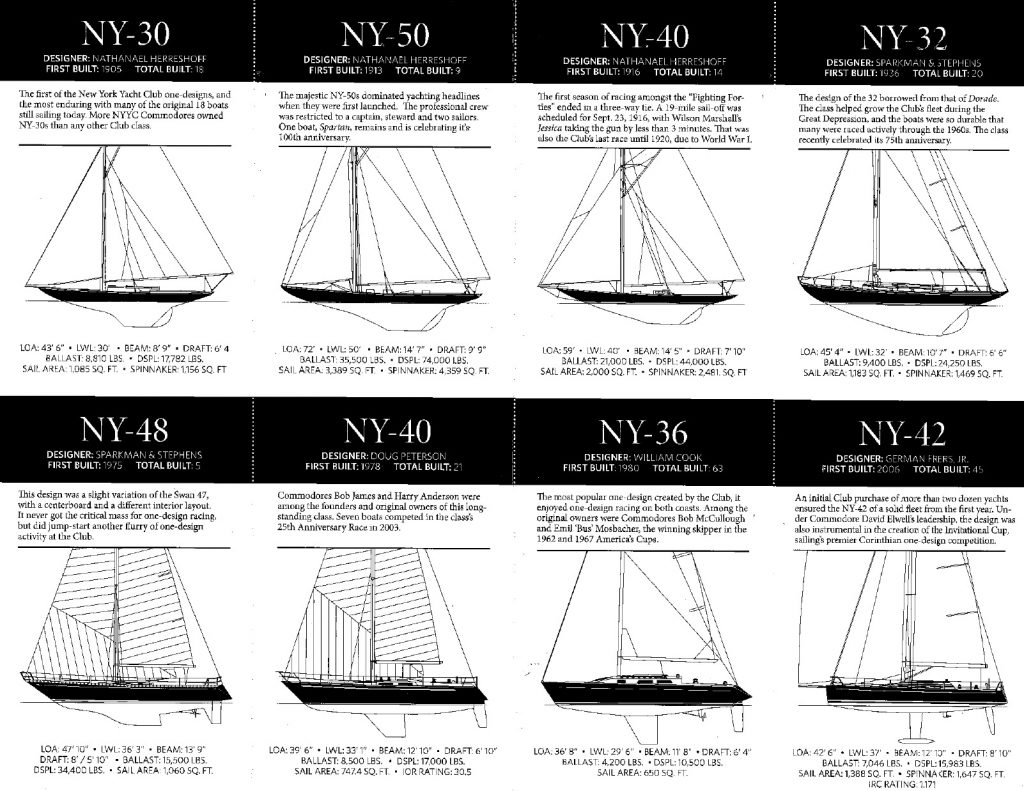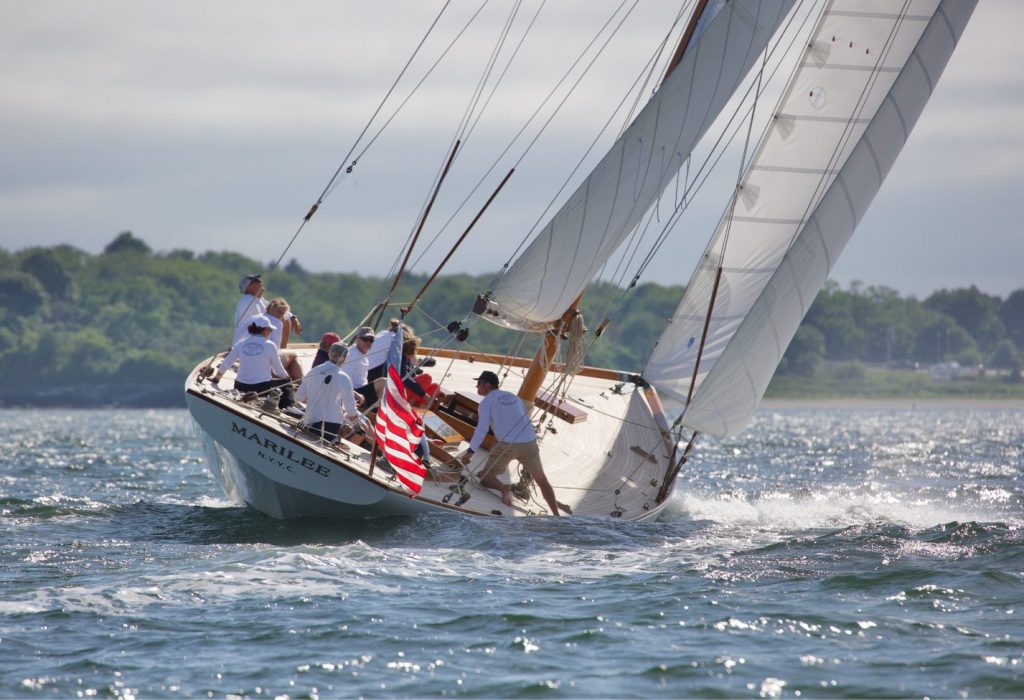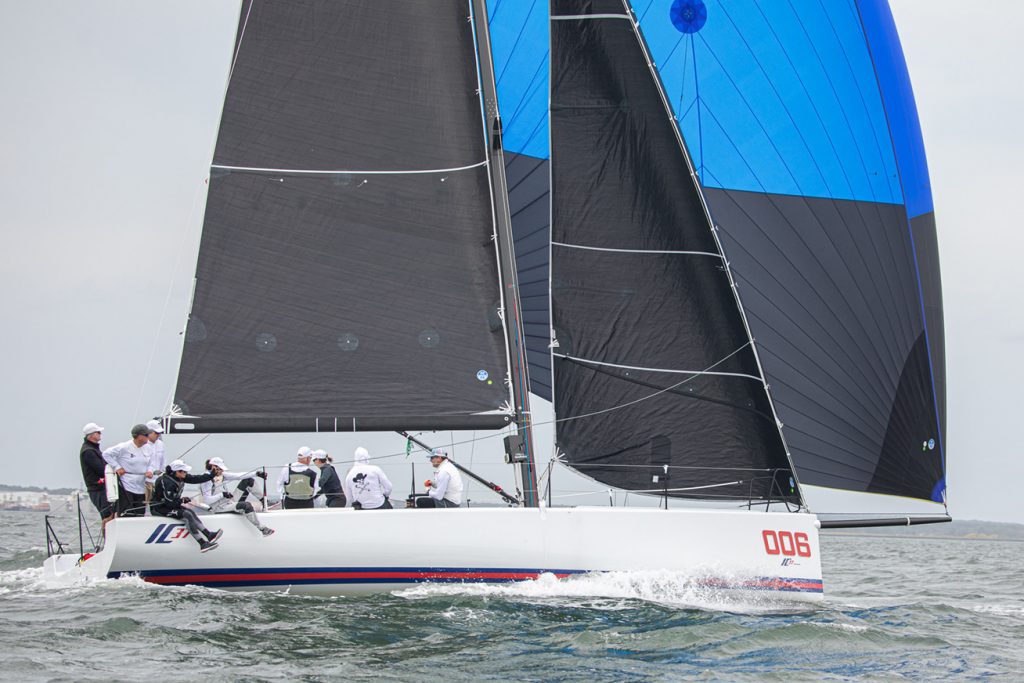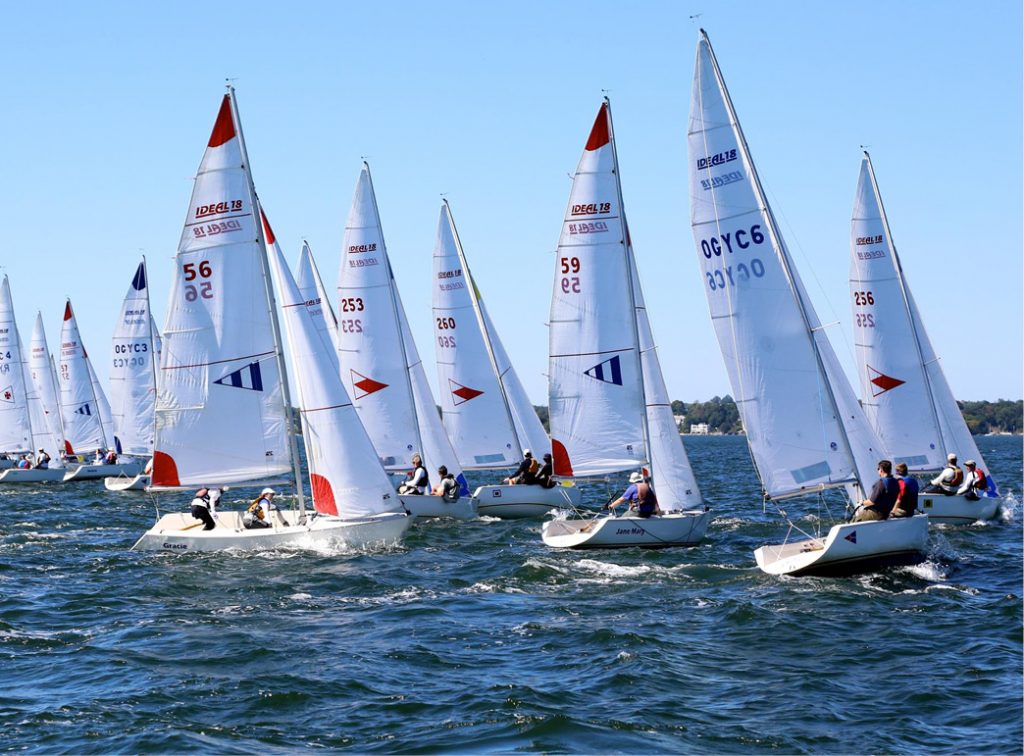In the Gilded Age, gentlemen sailors looked to designers like Herreshoff, Crane and Burgess for their custom sailing yachts. As the 20th century unfolded, however, a new age design emerged, that of the semi-custom keelboat, purchased by like-minded sailors interested in competing in fleets as one-designs. We call it the “Club Classic Keelboat.”
The idea of designing a boat to a single design or class was a 20th century phenomenon. When young Clinton Crane was commissioned in 1896 to design a lake sloop, the Idem, for well-heeled homeowners on New York’s Adirondack lakes, it was a novel commission for a novice boat designer. But very soon one-design keelboat fleets were taking root at sailing clubs elsewhere and taking hold in the imagination of the New York Yacht Club, the tastemaker for the yachting crowd. And of course, the Herreshoff Manufacturing Company in Bristol, RI was in the lead to supply its customers, big and small.

Courtesy of Wendy Lotz
In 2006, the same NYYC commissioned a new generation of one-design keelboats for fleet racing. This chart illustrates a century of NYYC-sponsored designs, from the New York 30 to the NY 42 (latterly known as the Club Swan 42 or simply Swan 42).
That one-design trend was not just about big boats, be it 1915 or 2015. In 1915, Herreshoff’s 15-footers fostered day racing for Corinthian crews as well as a new way of enjoying time on the water: daysailing with the family. In the 21st century, dual-purpose “club boats” have a similar theme in the designs of the late, great Bruce Kirby with the Sonar and the widely adopted Ideal 18.
NYYC by the Numbers
That early 20th one-design club keelboat was often a semi-custom, with a number that had no real relation to its hull characteristics. In Herreshoff’s case it was the NY 30, 40, 50, and 70. Only a Vanderbilt had the means to build a NY 70 to his specifications. A boat of that scale was more akin to Herreshoff’s massive America’s Cup boat Reliance, towering over her peers at 202 feet overall. Indeed, she might’ve been called a “NY 130!”
Even in those pre-income tax years, only one or two other 70s could be afforded, all built by Herreshoff. Reducing the waterline length of subsequent designs to 40-50 feet increased the fleet of orders for the NY 50 to nine. It was those 50s that inspired the development of the NY 40.
In his magnificent 2017 book Herreshoff, Maynard Bray relates the tale of how the NY 40 came to be. The series of NY-x designs (30, 40, 50 and 70) came more than a generation into the development of the more than 1,500 designs of the Herreshoff Manufacturing Company. With abundant full color images including copies of original plans and drawings, this retrospective exhibition of the finest Herreshoff designs provides a sense of the NY design series’ place in the classics universe:
“The NY 30 is one of the most successful one-designs ever created and one of the most beloved. The NY 30 had been the third class designed by Capt. Nat for NYYC members after the fin keel Newport 30s of 1896 and the four NY 70s of 1899. The 30s were followed by the 57s in 1907, the NY 50s in 1913 and finally the 40s in 1916.”
Ref: Herreshoff, Bray, Mendlowitz, van der Linde
“The 30 had been the first boats designed to the new Universal Rule, a departure from the Seawanhaka Rule of the last quarter of the 19th century. That rule produced increasingly radical and marginally seaworthy craft, the most dramatic of which was the monster America’s Cup boat Reliance.
“When the New York Yacht Club commissioned the new NY 40 one-design class in 1916, the Universal Rule was firmly in place and would be until after World War I. Herreshoff’s objective was to design a competitive yacht that was seaworthy enough for ocean racing yet also provided elegant accommodation to coastal cruising.”
The American Sailboat, Gregory Jones
“The rules required that the owner helm the yacht, except when the boat was on a run or a reach. Professional crew was limited to four with an additional two allowed when racing. The rest of the crew would be Corinthian sailors.”
Yachting World, May 2015
Hereshoff’s design came under criticism for its wide beam and high freeboard, a major shift from Capt. Nat’s earlier class racers with their long, low lines. It was given the moniker “flying saucer.” But all in all, the 40 was a more modern, practical boat, and a bridge in the 1920s to more modern designs. In 1920, a Herreshoff 40 cost an estimated $3,000 (about $72,000 in present dollars). The crew was also smaller, which had the effect of making the boat available to those of lesser means.
The twelve original NY 40s saw only two racing seasons before WW I put a halt to all racing. Sailing resumed – as in other popular classes like the International 6 Metre – in 1920. In 1926, two new NY 40s were launched. Marilee (HMCo hull #995 for Edward Cudahy) and her sistership Rugosa (#383) were identical in their lines, but Marilee had a newly designed coachhouse, accommodation plan and a larger cockpit.
NY 40s were known to race hard in their heyday, producing some infamous battles on the racecourse, and the phrase “Fighting Forties” has stuck to this day. The boats were also renowned for their hearty seaworthiness; despite their vast sail area they were rarely reefed.

Marilee © Scott Schuster
With twelve of the original eighteen boats surviving, the 40 is certainly one of the longest lived of the series. In 2015, sailable replicas are still afloat. The four in race-ready condition today are Rowdy, Chinook, Rugosa and Marilee, our featured boat. As the United States struggled after the war, the last of the NY-x designs were launched. Marilee was in that final group, floated in 1926. By 1927, most of the NY 40s had been sold, confined to cruising and very rarely raced.
The deployment of a Marconi rig and inclusion of an engine brought updates on the vintage track and Marilee and Rugosa keep on racing, with only the former Marilee retaining her interchangeable Marconi and gaff rigs.
In connection with the 2001 America’s Cup Jubilee in Cowes, 75 years after their launching, these two survivors tied for first overall in the Centennial Cowes Regatta.
A Refit for All Time
Few vintage boat restorations are as well documented as Marilee’s. The rebuild program is thoroughly explained in the 2015 Yachting World feature, available online. French & Webb in Belfast, ME was chosen to undertake the work, while Kurt Hasselbalch, former curator of the MIT Hart Nautical Collections which housed Herreshoff’s original plans and drawings, guided the trip through the voluminous plans within the mystical Herreshoff Brown notebooks. The Yachting World piece continued:
“In early winter 2013 they began with a 3D scan of the existing hull. This, combined with a CAD drawing created from the original Herreshoff plans, enabled the team to accurately examine Marilee’s current shape and compare it with the design from 1926.”
To ready Marilee for the demands of modern competition, the woodworking phase of framing and planking behind them, the boat architects moved the engine from an unsupported perch aft to the center of the boat. Refloated for a summer of racing in 2004, she came back to the shop for Phase II, the intricate process of disassembling and rebuilding the metal backbone of the boat. New chainplates tied to internal plates gave Marilee a new spaceframe over the original bronze framework. That work and a complete rebuild of the coachhouses, skylight, hatches, coaming and cockpit restored her above deck profile to the ‘lean, utilitarian, fine shapes’ that characterize a Herreshoff design. Even more noteworthy was her signature “Fighting Forties” pugilist logo etched in a mirror down below.
We witnessed the restoration’s product in 2017 at the dock during Nantucket Race Week. On the next dock over, she had gleaming topsides like her 1926 picture. Below, she sported a new straight line interior shining with gorgeous woods. We thanked the crew for our use of their exquisitely jointed bosun’s chair to recover the main halyard of our ride, the Newport 29 Dolphin. And we gawked.
Marilee’s Legacy: One Boat, Two Rigs
Marilee’s vital statistics
LOA: 53 (feet)
LWL: 40
Beam: 14’ 6”
Draft: 8.2’
Sail area: 2,100 square feet
Marilee is the only NY 40 to have had both rigs designed by HMC. All the original bronze hardware was reproduced to scale. While looking through all the original drawings for the boats, Hasselbalch discovered more Hull #995 plans for Marilee than he previously knew existed. In particular, he uncovered a drawing of a Marconi rig designed during a 1933 refit. To find this Herreshoff relic was an incredible discovery.
Today, owner Ken Kolburn relishes the option to sail Marilee with one of two different rigs. With a custom stemhead, he is able to attach a removable bowsprit capable of handling the bigger jibs of a Bermuda rig. At the transom, similar provision is made for the fixed backstay required for a full height rig that towers 84 feet above deck. That mast is hollow in section, built from eight staves, three in front, three in back and two side pieces giving a stiffer fore and after section. Making a wood staved mast at this level is art and science; we can attest to that with the 2006-built Alerion mast we use in Nantucket sailing.

The Melges IC37 continues NYYC’s tradition of commissioning speedy one-design keelboats. Courtesy of ic37class.org
Club Classic Contemporary
Club keelboat one-design was part of an early 20th century demographic shift in boat ownership and use in the U.S. As we have explored in the development of the International 6 Metre, the appearance of the Corinthian sailor introduced a new cohort of participants to the sport.
The same phenomenon returned in the early 21st century. Ken Colburn has had his finger in both generations of club racer; Marilee for Classics racing and the NYYC (nee Swan) 42 for the modern era. Now, a wider variety of sailors can assemble a Corinthian crew and stage a grand prix campaign.
When NYYC Commodore David Elwell put forward plans for a Club 42, he tapped into that same desire to expand high-level Corinthian sailing in the keelboat world. With over 45 built since 2006, the Frers-designed NYYC 42 was the catalyst for the well-known Rolex NYYC Invitational Cup.
NYYC is now racing their second 21st century fleet, having moved from the Frers 42 to the Melges 37, derived from a Mills design. Known as the IC37, it went into production for a new fleet of higher performance, sprit-enabled boats, which will be sailed by yacht club teams from around the world in the 2023 NYYC Invitational Cup in Newport this month.
Club Class: The Smaller Boat

Larchmont Yacht Club is hosting the Ideal 18 North Americans September 15 – 17. © Mary Alice Fisher/maryalicefisher.com
Over a century ago, club classics also came in smaller packages. The club one-design appeared starting in the 1910s with boats from designers like Herreshoff with 15 series, Buzzards Bay 15, Watch Hill 15, and others. Individual clubs commissioned a design and build plan for basic around-the–buoys racer/daysailers for two to four people.
Fleets of 15s formed throughout New England, hand in hand with the establishment of new racing groups like the CCA and launch of the first boating magazines like Yachting. These were the progenitors of fast one-designs like the Star, Atlantic and International One Design.
In the modern generation of designers, it was Bruce Kirby who led the development of the club keelboat fleet beginning with the 23-foot Sonar in Western Long Island Sound and Marblehead. In 1988, Kirby evolved his signature club keelboat design with the Ideal 18, and 425 have been built for racing and recreation.
I sailed one of the first Ideal 18s at Pequot Yacht Club in Southport, CT. We had great fun in the mid-‘90s match racing Ideals with a 2-person crew. The Ideal was exactly that for taking my 1992-born daughter on sailing trips, in her car seat strapped to the mast in order to get her to take a nap.
In his memoir The Bruce Kirby Story: From the River to the Sea, our departed friend tells the story of answering his friend Frank Shumway’s request for a sub-20 foot, two- or three-person keelboat. In our article and podcast on Bruce Kirby, we noted the similarity to his beloved Two-tonner Runaway: “The Ideal 18 was created as an easy to sail, non-threatening club racer for family crews.”
Today, clubs throughout the Northeast have expanded their sailing ranks with special summer programs with the keelboat. Big or small, classically vintage or ultra-modern, the Club Classic is an important design development that’s brought more people to sailing. Everyone into the Club Classic pool! ■
Suggested readings
Herreshoff: American Masterpieces, Bray, Mendlowitz, van der Linde
Yachting World, May 2015 (online)
The Bruce Kirby Story: From the River to the Sea
The American Sailboat, Gregory Jones
Not an historian but a boat storyteller, collecting and reciting stories for the boating curious, Tom Darling is the host of Conversations with Classic Boats, “the podcast that talks to boats.” Tune in via Apple Podcast, Google Podcast or Spotify, or online at
conversationswithclassicboats.com.




